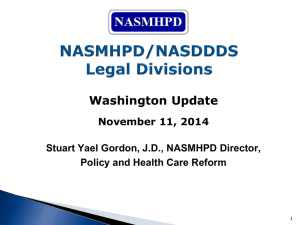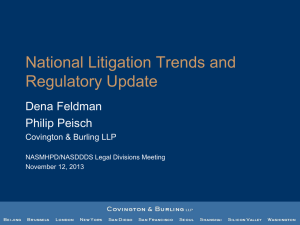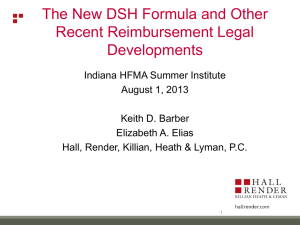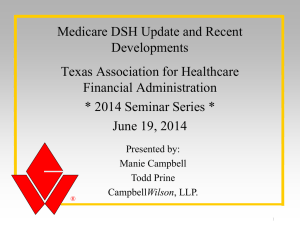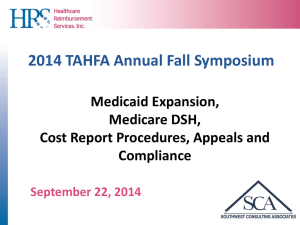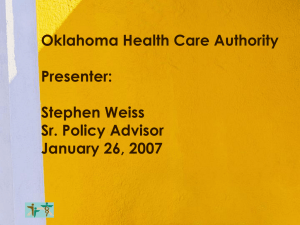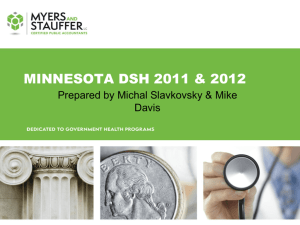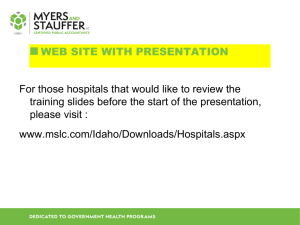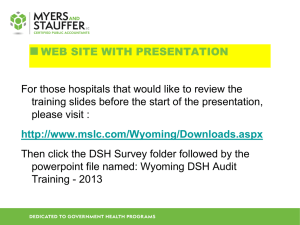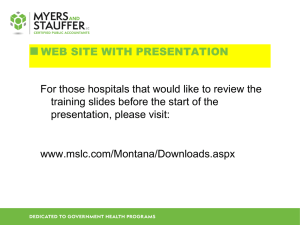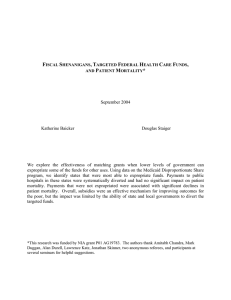KG v. Dudek - National Association of State Mental Health Program
advertisement
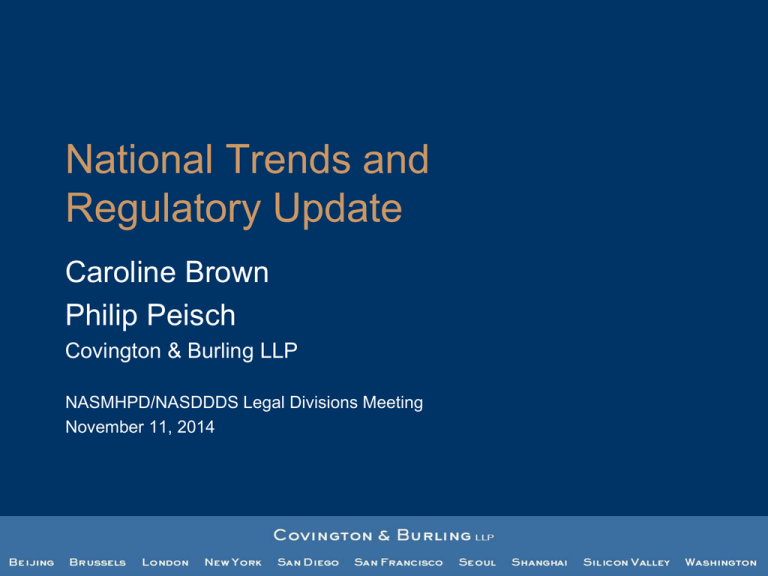
National Trends and Regulatory Update Caroline Brown Philip Peisch Covington & Burling LLP NASMHPD/NASDDDS Legal Divisions Meeting November 11, 2014 Medicaid Services for Children with ASD 2 Medicaid Services for Children with ASD • How should States cover Applied Behavior Analysis (ABA) therapy for children with autism spectrum disorder (ASD)? • Section 1905(a)(13) rehabilitative service? – Distinction between rehabilitative and habilitative services • • • • Section 1905(a)(13) preventive service? Section 1905(a)(6) other licensed practitioner service? Section 1915(c) habilitative service? Section 1915(i) habilitative service? 3 Medicaid Services for Children with ASD • Litigation over whether EPSDT requires coverage of ABA therapy for children. For example: – Chisholm v. Kliebert, 2013 WL 3807990 (E.D. La. 2013) – K.G. v. Dudek, 864 F. Supp. 2d 1314, 1319 (S.D. Fla. 2012), rev’d in part by Garrido v. Dudek, 731 F.3d 1152 (11th Cir. 2013) – Parents League for Effective Autism Services v. Jones-Kelley, 339 Fed. App’x 542 (6th Cir. 2009) 4 Medicaid Services for Children with ASD • Recent CMS guidance: Informational Bulletin (July 7, 2014) and FAQs (September 24, 2014) – Suggests EPSDT requires coverage of ASD-related services, but it is not clear which services are required and how States should cover them – Still unclear how States should cover ABA therapy • CMS did not take the position that ABA therapy is a Section 1905(a)(13)(C) rehab service – Increased litigation risk for States that do not cover ABA therapy 5 Medicaid Services for Children with ASD • Recent CMS guidance (cont’d) – A service cannot be covered for children under Section 1915(c) or Section 1915(i) if it is coverable as a Section 1905(a) state plan service – States that currently provide services coverable under Section 1905(a) to children with ASD through a Section 1915(c) waiver will need to transition those services to the state plan 6 Medicaid Expansion Update 7 Medicaid Expansion Update • 27 States, plus the District of Columbia, have agreed to expand Medicaid under the ACA – Several States have expanded through Section 1115 demonstrations • A few additional States are in discussions with CMS about expanding Medicaid 8 Alternative Benefit Plans 9 Alternative Benefit Plans • New low-income adult group will be covered by “Alternative Benefit Plans” (ABP), not state plan • ABPs are what used to be called “benchmark” coverage under Section 1937 10 Alternative Benefit Plans • ABPs must cover “Essential Health Benefits” – Complex ABP design process: compare/combine Section 1937 plan with commercial base benchmark plan – “rehabilitative and habilitative services and devices” • CMS: ABPs must include habilitative services – “mental health and substance use disorder services, including behavioral health treatment” 11 Alternative Benefit Plans • Mental Health Parity and Addiction Equity Act (MHPAEA) applies to ABPs • Institution for Mental Disease (IMD) Exclusion – CMS applies IMD exclusion to ABPs, even though ABP coverage is “[n]otwithstanding . . . any other provision of this title which would be directly contrary to the authority under this section”. See § 1937(a). – Problems with application of the IMD exclusion • Increasing demand for inpatient MH/SUD treatment (particularly in the new group of low-income adults?) • Application of IMD exclusion is in tension with MHPAEA 12 Alternative Benefit Plans • “[M]edically frail or otherwise an individual with special medical needs” are exempt from mandatory enrollment in an ABP and must be offered state plan benefits, including ICF/ID – Includes individuals with disabling mental disorders and individuals with chronic substance use disorders • HCBS waivers may be opened to new group, but are not required – Olmstead implications 13 Medicaid and the Mental Health Parity and Addiction Equity Act (MHPAEA) 14 Medicaid and the MHPAEA • MHPAEA applies to: • Medicaid managed care • Alternative Benefit Plans • CHIP • MHPAEA does not apply to: • Medicaid fee-for-service 15 Medicaid and the MHPAEA • November 2013: final MHPAEA rule • December 2014 (expected): Notice of Proposed Rulemaking, “Application of the Mental Health Parity and Addiction Equity Act to Medicaid Programs” 16 DSH Allotments 17 DSH Allotments • ACA’s DSH reductions – – – – $500 million in 2014 Increase to $5.6 billion in reductions by 2019 Congress extended to 2022 In September 2013, CMS finalized a DSH Reduction Methodology for 2014 and 2015. 78 Fed. Reg. 57,293. 18 DSH Allotments • Changes and Delays to the ACA’s DSH Reductions – December 2013 budget bill • Eliminates the FY 2014 and FY 2015 DSH reductions • Doubles the FY 2016 reduction from $600 million to $1.2 billion • Extends reduced DSH allotments by one year to FY 2023 – April 2014: Protecting Access to Medicare Act • Eliminates the FY 2016 DSH reductions • Decreases DSH reductions for future years • Extends reduced DSH allotments by one year to FY 2024 19 DSH Allotments • President Obama’s Fiscal Year 2015 budget – Current law: DSH reductions end after 2024 – President Obama’s budget would effectively extend the cuts indefinitely by determining all future DSH allotments beyond FY 2023 based on the State’s actual DSH allotment as reduced by the ACA 20 DSH Allotments • Section 1923(h) of the SSA imposes limits on the DSH payments for IMDs, which cannot exceed the lowest of: – The percentage of the State’s DSH payments paid to IMDs in 1995 – The dollar amount of DSH payments made in 1995 – 33% of the State’s DSH allotment 21 DSH Allotments • The ACA’s DSH Reductions’ Impact on IMDs – CMS: “for FY 2014 and FY 2015, we will calculate the IMD DSH limit under section 1923(h) . . . based on the DSH allotment after reductions implemented by the final rule to ensure that the IMD limit experiences a corresponding reduction consistent with the overall reductions in annual state DSH allotments.” 78 Fed. Reg. 57,293 (Sept. 19, 2013). 22 New FLSA Rules for Home Care Workers 23 New FLSA Rules for Home Care Workers • Background: Fair Labor Standards Act (FLSA) statutory exceptions – “Companionship services”. 29 U.S.C. § 213(a)(15). – With respect to overtime only, domestic service workers who reside in the private residence in which they work. 29 U.S.C. § 213(b)(21). 24 New FLSA Rules for Home Care Workers • New rules will remove many home care workers from the exceptions to the FLSA • Narrows “companionship services” to mean primarily “fellowship and protection.” – Assistance with ADLs/IADLs must be “attendant to” fellowship and protection and “not exceed 20 percent of the total hours worked.” 29 C.F.R. § 552.6. • Prohibits third party employers from taking advantage of exceptions for companionship services or live-in domestic workers. 29 C.F.R. § 552.109. 25 New FLSA Rules for Home Care Workers • New rules effective January 1, 2015 • DOL’s 2015 non-enforcement policy. • 79 Fed. Reg. 60974 (Oct. 9, 2014) • First half of 2015: no DOL enforcement actions • Second half of 2015: DOL “will exercise prosecutorial discretion in determining whether to bring enforcement actions, with particular consideration given to the extent to which States and other entities have made good faith efforts to bring their home care programs into compliance with the FLSA since promulgation of the Final Rule” • Does not delay effective date of the new rules 26 New Home- and Community-Based (HCB) Setting Standards 27 New HCB Setting Standards • HCBS under Section 1915(i), Section 1915(c), or Section 1915(k) must be delivered to individuals living in an HCB setting • January 2014: new final rule defining HCB setting – 79 Fed. Reg. 2948 (Jan. 16, 2014) – Effective March 17, 2014 28 New HCB Setting Standards • General standards for HCB settings • Special rules for provider-owned and provider-controlled settings 29 New HCB Setting Standards • State transition plans – Deadlines • If the State renews or amends a Section 1915 benefit or waiver before March 17, 2015, the transition plan for that specific benefit or waiver is due at the time of renewal/amendment and a transition plan for all the State’s other benefits/waivers is due within 120 days thereafter • If the State does not renew or amend a Section 1915 benefit or waiver by March 17, 2015, the transition plan is due for all waivers/benefits by March 17, 2015 – 30-day public comment period – Transition period of up to five years if the State can show a need for that time 30 Questions? 31

